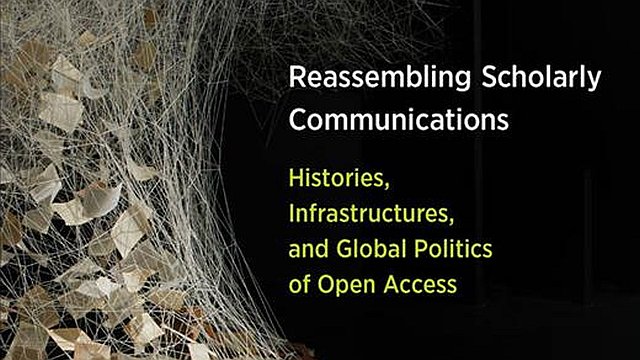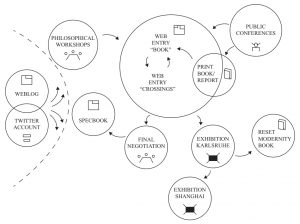
Open access to scholarly knowledge in the digital era (chapter 2.2): How does a format make a public?
This article is chapter 2.2 in section 2 of a series of articles summarising the book Reassembling Scholarly Communications: Histories, Infrastructures, and Global Politics of Open Access.
In this second chapter of the knowledge cultures section, Robin de Mourat, Donato Ricci, and Bruno Latour explore how different scholarly formats can be used to embark on new ways of gathering collectives of scholars and practitioners around an area of research interest. In doing so, they draw on the experiences of their project An Inquiry into Modes of Existence (AIME). They describe the collectives of scholars and practitioners as “transdisciplinary publics.”
de Mourat, Ricci, and Latour contend that if it is acknowledged that the format of an academic text significantly affects the communication functions and practices attached to it, then the interactions between format names and experiences take on some significance. For example, “journal,” “monograph,” and “conference proceedings” are just a few names of formats that evoke the institutions and practices of the academic world. On the one hand, these different formats establish a shared framework for thinking, reading, and writing, and connect specific institutions, infrastructures, and activities. On the other hand, they contain diverse and differentiated expectations depending upon disciplines, countries, and schools of thoughts.
The definition of a format followed by de Mourat, Ricci, and Latour comes from publishing, being a “a set of historical processes and practices – composition, editing, design and illustration, production, marketing and promotion, and distribution – and a set of relations with various other institutions – commercial, legal, educational, political, cultural, and, perhaps, above all, other media.” They stress that the recognition process of a format among others is not only a process happening “in the mind” of readers of writers, but rather an actual agent for organizing a broad range of material practices, including technologies and material setups allowing for a certain format to be recognized but also acknowledged.
They also advise, based on work on the format of the “blog,” that formats are understood as the result of local and dynamic processes of stabilization implying technological platforms and cultural practices. They state that the survival of long-lived academic formats, despite the diversity of the individual formats they designate, is certainly the expression of such a dynamics of stabilization, allowing some academic institutions – the Library, the Academic Journal, the University Press, and so on – to persist until today.
This means that formats play a great part in building horizons for writing, reading, and publishing practices associated with academic research in specific environments and disciplines. However, de Mourat, Ricci, and Latour alert that these horizons are becoming blurred and challenged by new collective environments and intellectual projects.
AIME: making a format for transdisciplinary publics
de Mourat, Ricci, and Latour advise that a substantial challenge for contemporary academic publishing can be seen in transdisciplinary, open humanities projects that seek to gather diverse communities of scholars around a shared inquiry or object. To that extent, several initiatives have actively experimented with new forms of publishing to gather collectives of concerned participants in new ways. Among these experiments stands their project An Inquiry into Modes of Existence (AIME).
AIME is a philosophical investigation that aims at learning “how to compose a common world” by redefining what should be understood under the adjective “modern” when describing contemporary society. To that extent, the purpose of AIME was to gather a collection of accounts of various “modes of existence.”
The project was initiated by Bruno Latour, who asked other scholars and stakeholders to enrich, expand, and criticize his initial propositions. The project therefore consisted of transforming an individual argument into a collective endeavor involving an active public capable of grasping the subtle nuances of the various modes of existences. The project’s challenge lay in the gathering of a public, constituted of scholars from various disciplines and backgrounds, but also incorporating practitioners, able to act as representatives of that for which they cared; for example, lawyers for the mode of law, priests for the mode of religion, artists for the mode of fiction, and so forth.
The next step was to encourage them to contribute in a constructive way to the elaboration of a new, collective account of the modes of existence. Working with such a range of participants meant that the project needed to accommodate a diversity of backgrounds, skills, and motives for contributing, whether they be advancing personal scholarly questions, defending an issue about which they care, receiving academic recognition, or simply satisfying their intellectual curiosity.
For these purposes, the AIME team – comprised of humanities scholars, designers, and engineers – has developed an infrastructure that aims to provide an underpinning for the various readers of the project, but that also involves some of them in the project’s documentation and amendment, transforming their status from readers to contributors.
To achieve this, the project was designed as a distributed collection of different editions that were dependent on each other, as shown in Figure 1. These editions of the inquiry were as different as: a printed document, a website attached to several digital interfaces to the project, and a varying set of workshops and exhibitions. While they all revolve around the same shared purpose, the documents featured by these editions only partially overlap, and the activities they support are radically different – from bookish reading to slide-based digital composition, from oral document-based discussions to online collective writing – not forgetting exhibition-based thought experiments.

Even though the editions were diverse and disparate, they were not developed in isolation. A database was established to feed both web interfaces of the project. In turn, the web interfaces were used as stimuli for physical meetings, and vice versa. The database has supported the web applications of the project to provide an empirical experience of the inquiry. The web application has supported the contribution process, being used in physical meetings, which were in turn used to fill the database. The ecosystem of AIME, therefore, has been built as an interrelated set of dependences that could not be sketched in a linear way. This ecosystem as a whole was meant to act as an infrastructure for the inquiry itself, understood as a set of connected systems supporting the collection of accounts.
de Mourat, Ricci, and Latour advise that while the AIME ecosystem was built as an infrastructure, it is nonetheless its format that has been experienced by its public, because readers only encountered the project through one of its diverse outlets. The editions never appeared simultaneously to the public, both because they were not published synchronously but also because each new reader enters the project through a chance encounter with one of the editions and then discovers the others progressively, while situating each of these encounters within their preexisting cultures, practices, and expectations.
How, then, did the format of AIME act on the public engagement with the project itself?
How horizons of practice shape publics
de Mourat, Ricci, and Latour conducted a systematic review of feedback that described (and critiqued) the organizational and material infrastructures of the AIME project. This allowed them to grasp, to some extent, the contours and internal geography of the public constituted by AIME. For their review, they focus on three of the diverse formats: a “philosophy book,” a “blog,” and an “encyclopedic” format.
AIME “is a philosophy book.” Despite being continuously labeled as an “interim report” in the project team’s vocabulary, the output was published by bodies recognized for providing the philosophy book genre of publication (Harvard University Press and La Découverte for the respective English and French versions, for instance), and has been called as such by most of the reviews.
Moreover, the digital edition points to a space explicitly labeled as “book,” while not fitting with the experience expected from what is commonly associated with this name. Despite repeated announcements of this fact, as well as notes in the forewords, within the core of the text, and in the project’s blog or public presentations, de Mourat, Ricci, and Latour observed that many reviews (including from subscribers to the mailing list of the project!) did not take into account the form of the digital editions, and some critiqued the lack of textual features and evidence normally found in a book – while this was abundantly available online. These misalignments produced unexpected interpretations of the very content of the report.
AIME “is a blog.” This label was assigned to one of the openly accessible formats in several ways: as an oppositional stance about the way coinquirers’ contributions were specified in their roles (contributions to content rather than comments), as a comparison anchor for assessing the features of the project as more or less innovative, and eventually as an actual part of AIME’s vocabulary for describing one of the editions of the setup (AIME’s official blog).
AIME “is encyclopedic.” Interestingly, the project was called such on several occasions, although this term was not used within the team’s own internal vocabulary. Further, in contrast to the other examples quoted above, it was used as an adjective, rather than as a clear nominative label. When looking at these designations, it is clear that some commentators associate AIME with an encyclopedia from the systematic nature of Bruno Latour’s proposition of modes of existence. That said, others seem to home in on the presence of controlled vocabulary – strongly signaled in typographic design, and in the open web edition’s layout – to qualify the project as encyclopedic. This presupposition provoked claims and critiques; for instance, about the absence of some topics from the book, and a precise inquiry about the approach to language performed by the project itself.
Interestingly, and adjacent to the strict “encyclopedic” naming of the project, old and new formats of the encyclopedia collide in this movement of association as the collective nature of AIME has also prompted its association with Wikipedia. As a result, the project has been approached by communities of persons interested in wiki technologies, who in return asked about the absence of some features and the dissonance with a wiki’s traditional editorial projects in the AIME project.
The labels used in published reviews of the project are just a subset of clues that point to a broader set of recognitions that de Mourat, Ricci, and Latour witnessed in oral exchanges and interviews around the AIME project. Through a series of displacements and comparisons, the project was understood, interpreted, and used in a variety of ways by the actors gathered around it. The distributed strategy of AIME has clearly produced a variety of sticking points that were understood in the framework of specific recognition processes, successfully assembling around the project a diversity of actors coming from different backgrounds and having entered into the collective from a variety of its instances.
The result of this aggregation process has fostered, among other outcomes, a total of 134 contributions and 61 unique contributors to the web editions, and a “specbook” collectively written by a group constituted both of Latour’s familiar collaborators and of new participants encountered through the project.
However, the distributed, open strategy of AIME and the peculiarity of its different editions has also generated a wide range of expectations and requirements about the methodology and infrastructure of AIME, taking advantage or disadvantage of these in order to develop specific sense-making practices. If AIME is not relatable to any previous way of conducting and staging a philosophical inquiry, its constitutive editions have been.
de Mourat, Ricci, and Latour advise that the formats of AIME, therefore, jointly produced plural horizons of practices where a collective adventure could take place relying on the infrastructure of the project. These horizons had both an influence on the composition of the public – who got in and who did not – and on its conduct, shaping practices and attitudes in a variety of ways.
How does a format make a public?
de Mourat, Ricci, and Latour conclude that AIME’s experience has shown that distributed and open publishing strategies foster a complex tension between aggregation – pulling diverse members into the collective – and participation – developing common practices and endeavors. The distributed collections of various editions implied by multimodal strategies of inquiry foster a play of repetition and difference in which the format of a project yields the recognition of formats among others that gather new participants into the research collective. This brings diverging horizons of practices that align to drive the actual appropriation, transformation, and opening of the research infrastructure.
Although not always easy to handle, de Mourat, Ricci, and Latour state that the displacements and divergent perspectives on the project not only succeeded in bringing a wide range of different scholars and practitioners into the debate, but also in fostering unexpected perspectives and fueling rich discussions around the project’s issues. They advise that if format – singular – acts at the boundary of production and experience, formats – plural – are essential to understanding the way in which this boundary is traversed by the diverse public of transdisciplinary scholarly projects.
Contemporary environments of scholarly publishing are constituted de facto by a set of places, organizations, technologies, and forms that vastly overflow the geography traditionally covered by dedicated institutions such as publishers and libraries, and their related models of practice and positions in academic worlds. This implies radical changes for these dedicated institutions themselves, as a rich literature in bibliographic and information sciences has shown. Nonetheless, de Mourat, Ricci, and Latour state that one can also wonder how these new geographies will continue to transform the way researchers conduct and envision their work.
As de Mourat, Ricci, and Latour have shown through their account of the AIME project, the role of publishing-related activities continually evolves beyond traditional functions of research dissemination to transform the very core of their activity.
First, this transformation operates on a methodological plane: instead of practicing publishing as a way to present achieved results or even to test intermediary hypothesis, formatted research enables publishing activities to genuinely act as research methodologies, because they center upon encounters of concerned individuals within a meaningful infrastructure to put a specific issue to work.
Second, this evolution deals with an aesthetic and design-related transformation: how can the thoughtful and patient deployment of a research process into complex “postdigital” settings affect, refine, and transform its research questions? How then should we understand the nature of the arguments being built in these processes, and find ways to account for them in subsequent works?
Third, this transformation deals with the political and organizational definition of what can be called a research collective today: how to take advantage of the aggregating power of open and multiform formats yielded by multimodal publishing strategies? de Mourat, Ricci, and Latour state that this question acts at the same time as a promise for renewed research collective formations, and as a challenge – if not a radical questioning – for institutions, in a context where formats make publics, set expectations, and orient sense-making practices as much as well-defined organizations.
Next part (chapter 2.3): The evolving role of readers in peer review.
Article source: This article is an edited summary of Chapter 61 of the book Reassembling scholarly communications: Histories, infrastructures, and global politics of Open Access2 which has been published by MIT Press under a CC BY 4.0 Creative Commons license.
Article license: This article is published under a CC BY 4.0 Creative Commons license.
References:
- de Mourat, R., Ricci, D., & Latou, B. (2020). How Does a Format Make a Public? In Eve, M. P., & Gray, J. (Eds.) Reassembling scholarly communications: Histories, infrastructures, and global politics of Open Access. MIT Press. ↩
- Eve, M. P., & Gray, J. (Eds.) (2020). Reassembling scholarly communications: Histories, infrastructures, and global politics of Open Access. MIT Press. ↩
Also published on Medium.




